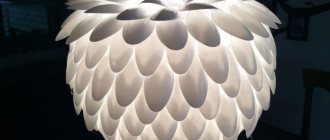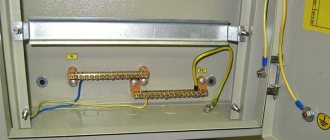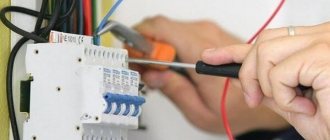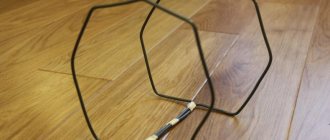Floor lighting in residential and adjacent spaces has become a fashionable trend in modern interior design in recent years. This method not only brings special originality to the design of rooms, but is also a completely functional component of the overall lighting system.
Floor lighting
You can equip any of the rooms with floor lighting, which will allow you to go to the desired place in your apartment or house in the dark, without turning on the overhead lights, without bumping into obstacles. Motion sensors simplify the operation of the lights. So, when motion is detected, the lights will light up automatically, eliminating the need to look for a switch in the dark.
Requirements for lighting devices
If you liked such an extraordinary solution as organizing floor lighting in your apartment, before you start choosing lamps, you need to understand that the requirements for them will be completely different than for ceiling lamps. Naturally, this is due to the method of their installation, and the fact that at any moment you, your children or pets can touch the surface of the lamp and many other factors.
In details:
- First of all, do not forget that the floor is a surface that is constantly subjected to wet cleaning. It follows that in order to prevent the lamp from failing or, even worse, a short circuit, it is necessary to choose devices with a moisture-resistant housing. The packaging of any modern lamp must indicate the degree of protection against moisture, which corresponds to the numbers and letters “IP”. Ideally, the value will be IP 44 – 67;
- You also need to choose lamps with durable, shock-resistant housing. For example, if a lamp is mounted on the floor in the hallway, then it can easily be damaged by stepping on its surface with a heel; in any other room, something heavy can fall on the floor, etc.;
- Since the light flux in this case will be directed from bottom to top, it should not be too bright and dazzle or cause discomfort. This is especially true for lighting in hazardous areas such as stairwells. The purpose of the backlight is only to indicate boundaries or set a direction, but in no case to act as an additional light source. Therefore, low-power devices with diffusers are quite sufficient;
- Fire safety is a very important condition . Sometimes, if the device does not meet these requirements, the baseboard in which it is supposed to be installed melts, which leads to more dangerous consequences;
- The body of the lamp should not heat up , otherwise you may get a burn after involuntary touching;
- Among the variety of floor lamps offered, it is still worth giving preference to LED light sources. Not only are they among the most affordable, but they also consume the least amount of electricity. Plus, we can say that their installation is quite primitive.
Reasons for the popularity of floor lighting
To understand why this option for decorating a house or apartment is quickly gaining an army of fans, it is enough to evaluate the merits of this solution, and then try to find its serious disadvantages.
What are the benefits?
Traditionally, they start with a list of benefits. Original floor lighting has many advantages.
- One of the main tasks of any lighting is to create accents to draw attention to some of the most advantageous elements of the interior.
- Lamps that are located around the perimeter of the room can visually expand the space and push the boundaries of a small room.
- Originality, freshness. This solution allows you to make each home unique, highlight the taste of the owners, add individuality to the rooms and add special comfort.
- Zoning space using floor lighting. This is a little more complicated than zoning with ceiling lights, but it is also possible. For example, podiums or steps of a staircase are “marked” with light.
- Host security is a benefit that deserves to be at the top of this list. The illuminated floor gives residents the opportunity to get to any room in the dark without “adventures.”
- Maximum comfort. Floor lighting can completely replace other lighting devices, especially in the evening, when bright light is contraindicated for the eyes, since they need rest, and the owners will not be disturbed by relaxation after a busy day.
The capabilities of a “smart home” are another undeniable advantage, which not only allows you to minimize energy consumption, but also ensures comfort. The lighting with a motion sensor will turn on itself and turn off when the owners leave the room. This device is installed on the first illumination section. The optimal device for indoor use is an infrared sensor.
Does backlighting have any disadvantages?
The disadvantage is the additional costs that are inevitable due to the purchase of lighting fixtures, their installation and operation of fixtures that require energy. However, the disadvantages are relative, since the savings on energy bills will soon become noticeable, and the appearance, efficiency and home comfort will quickly “make” you forget all previous experiences.
In what rooms is floor lighting appropriate?
The beauty of this type of mood lighting is that it really works in all rooms. And in some, it is even preferable:
- In bathrooms and toilets, the area of which can be called record-breakingly modest, floor lighting will help to visually make the room more spacious. The lighting combines especially well with hanging plumbing fixtures. The soaring effect is enhanced significantly, and a soft level of lighting is created in the room, pleasing to the eye, especially at night. In this case, be sure to choose lamps with the highest degree of protection from moisture, especially if they are located near a sink or bathtub;
- Illumination is also relevant in hallway It is this room that guests of your home first enter, which is why many designers call the corridor the calling card of the house. Its interior should not only be laconic and functional, but also meet aesthetic requirements. Often the corridor in apartments with a standard layout is a long rectangle. In this regard, ceiling lighting alone is often not enough. Of course, if the spotlights are not located along the entire length of the ceiling in small increments. It is recommended to use a multi-level combined lighting system. For example, several light points on the ceiling, wardrobe lighting, if there is one, and floor lighting. This approach will not only fill the entire room completely, but will also make it more spacious;
- Subdued soft lighting is also relevant in the children's room, especially if your child is afraid to fall asleep in the dark. Various night lights or projectors can involuntarily concentrate attention on themselves, thereby preventing you from quickly falling asleep, which is not the case with an LED strip glued to the bottom of the bed or mounted in the floor plinth;
- IN living room or in an adult bedroom, lighting is often decorative in nature, but can be used as a method of light zoning;
- A favorite technique of many designers is to illuminate the kitchen using a diode strip attached to the kitchen unit. It looks really impressive, especially if you choose the right color for the glow of the ribbon, and the interior itself is instantly transformed. In this case, it is necessary to take into account whether the room’s design belongs to a particular style. Since such a solution is more suitable for modern styles than for classics.
Features of toilet lighting
Since this room is most often small in size, and the operation differs from ordinary rooms, you need to understand the main features in order to choose the best solution:
- The brighter the lighting, the greater the effect of expanding the space, which is very important. If the walls and ceiling are light, this will also have a positive effect. But at the same time, you need to choose the brightness so that the lamps do not create discomfort for your vision.
There should be enough light, this visually expands the space. - Yellow dim light is contraindicated for this room, as it further reduces the space and creates discomfort.
- It is better to use diffused or reflected lighting; it does not create discomfort for vision and does not require special settings. Lampshades come in different shapes and sizes, so it’s easy to choose a model to suit any setting. When using directional light, it should not enter the eyes and create glare when reflected from the walls.
If there is a sink in the bathroom, it is worth placing a small lamp near it so that when washing hands a person does not block the light.
A simple way to save on electricity
In the context of a constant increase in tariffs for utility services, almost everyone is trying to arrange their home in such a way as to reduce heat loss, water costs, etc. to the maximum. To save electricity, special meters called “day/night” are installed and energy-saving types of lamps are used. In addition, lighting can be made “smart” and further reduce energy costs. To do this, the system is equipped with motion sensors.
This way the light will only turn on when needed.
several types of motion sensors
- Infrared;
- Sound;
- Microwave;
- Combined.
Infrared models are the most convenient They allow you to configure the operation in such a way as to eliminate false positives. For example, when moving pets. Combined sensors can also be considered for home use. Their cost is much higher due to the presence of two types of signaling devices in the system. But with their help, you can eliminate the risk of false positives almost completely. The remaining two types are in most cases used for installation outside buildings.
LED Installation Instructions
To install lighting on the floor yourself, it is recommended to use LEDs. The easiest way to work with them. Install the diodes immediately before laying the tiles. If the tiles are already laid, another option is to install lighting along the tile seams. To do this, you will need to clean the grout from the seams.
The work is performed in this order:
- Buy LED lamps originally intended for floor installation. A distinctive feature of such diodes is the presence of ready-made cross-shaped supports, thanks to which they are securely fixed between the tiles. Such diodes are not cheap, but this is their only drawback. If you wish, you can save money by buying standard LEDs and connecting them with wires. It is also necessary to treat all conductors with silicone to make them resistant to moisture.
- Connect and seal the cores with heat shrink.
- Do not leave the power supply outside; it is better to hide the wires under the baseboards.
- Make sure the backlight is working properly.
- If everything is ok, dip the wires in glue and let dry.
- Check the system again for proper operation. If the backlight is working properly, process the seams with a jointer. Remove any remaining glue with a flat sponge.
Note! The joints should be slightly below the level of the tiles (about a couple of millimeters). This will prevent them from being knocked over when walking.
Installing spot lighting
Such lamps are mounted in the corners of the room, along its perimeter, on the walls near the steps of the stairs or in the risers. First, they determine the installation location and decide whether it is advisable to add motion sensors to the system. Next, they buy lighting fixtures, conductors and a switch (sensor), and look for the area from which the backlight will be powered.
Illumination using spotlights
The use of spotlights makes the process of organizing floor lighting simpler and less expensive.
The advantages of point elements are obvious:
- Affordable price;
- Variety of designs, styles and sizes;
- In addition, spotlights can become a decoration or highlight of the entire interior due to interesting lighting effects. This refers to how the lamp directs the flow of light. After all, some models can project different light patterns onto the base;
- Long service life;
- Compatible with energy-efficient lamp types;
- Housing tightness;
- Impact resistance;
- Possibility of purchasing lamps with a high degree of protection against moisture.
The disadvantage is that during prolonged operation the lamp body heats up to significant temperatures. Therefore, before giving preference to this type of lighting, think about how exactly the lamp will be mounted and whether it will be possible to exclude the possibility of involuntary touching.
Useful tips
Several useful recommendations that will simplify the selection and installation of floor lighting in the apartment:
- It is better to buy an LED strip equipped with a dimmer. This device allows you to adjust the brightness of the light. In addition to convenience, this is also a great way to save on electricity consumption.
- In addition to lighting, it is advisable to install built-in lighting for stair steps in the floor covering. You can also install lamps in the handrails of the stairs.
- As an alternative, instead of installing cornices, you can place the tape under the facade of the furniture, or install the tape inside the flooring if you purchase transparent tiles made of durable glass.
- The floor must be absolutely flat, otherwise the backlight will reveal all surface defects.
- To achieve bright illumination, it is recommended to use ribbons and cords of small diameter but high power. If the task is to create diffused soft lighting, you will need products of large diameter.
- When installing the tape, you must proceed from the connection diagram. Incorrect connection of contacts will lead to damage to the lamp.
- During electrical installation work, the electricity in the room must be turned off.
- The tape can be shortened. However, cutting should not be done arbitrarily, but only in a place specially designated for this purpose.
- You shouldn't save money on buying an LED device. Purchasing cheap Chinese goods from unknown manufacturers will very soon result in a system malfunction.
In most cases, organizing floor lighting does not require any special knowledge, but there are a lot of nuances in this work. Violations of technology will not allow creating an effective lighting system. If there is no firm confidence in the correctness of the actions, it is better to entrust this work to specialists.
How to properly install spotlights?
There are several ways to organize floor lighting using spotlights. The difference will be in the surface into which the lighting fixtures will cut.
- This could be the plane of the wall;
- plane ;
- Or furniture facades.
It is rational to use the first case if the idea of arranging such lighting came to you after the finishing of the floor was completed. It will be especially successful if your desire coincides with the need or desire to change the wall decoration. After all, in order to install lamps in the wall, first of all, you need to provide an electrical cable supply to the installation site. This means you will have to knock down the walls. It is best in this option to make one wide groove almost at the very floor, lay the required number of wires in it, and then ensure that each wire is connected to a point. With this arrangement, much less cable will be required, and in the future you will be able to hang a shelf or picture anywhere on the wall and not worry about driving a nail into the wire. But you should not make the groove too low. Don’t forget that you will probably also have to install the floor plinth.
Accordingly, the groove should be higher than it:
- Step back 5-6 cm from the floor and draw a line. This will be your baseboard.
- Make marks with a pencil that will correspond to the number of lamps. Assess their location and frequency.
- Draw another line that will correspond to the lower edge of the lamp, and then the upper one, which will limit the installation area and correspond to the height of the lamp.
- Now you can clearly see that it is better to place the strobe above the light points and you will know exactly where.
An interesting way would be to install lamps in niches specially equipped for this purpose.
However, this will require covering one of the walls with plasterboard.
It is rational to do this if at the same time it is necessary to insulate the room and if the usable area of the room will not suffer from this. If the installation will be carried out in the floor plane, you need to think through everything in advance:
- In the case of wooden floors, the wires should be laid under the joists, and where the light point will be located, a branch of such length is made that it extends 10-15 cm above the floor surface;
- If finishing the floor includes the stage of arranging a concrete screed, then the wires must be laid under cement mortar. First, do the wiring, then install special plastic or metal landing capsules for the lamps. They can be fixed using the same cement mortar. At this stage, there is one very important nuance that you need to be careful with. The capsules must be installed so that after installing the luminaires in them, their surface is flush with the finish of the floor. To do this, you need to take into account the thickness of the screed; in the case of ceramic tiles, add the thickness of the tiles and a layer of adhesive; in the case of laminate or parquet, add the thickness of the boards + the thickness of the substrate;
- Then, as the finishing coating is laid, holes for the lamps are made using round cutters.
Installing lamps into furniture frames is perhaps the simplest method that does not require radical measures. Most often, lamps are installed in a mounting strip that covers the legs of wardrobes or kitchen units. The advantage is that you can supply electricity to the right place using a regular extension cord.
What lamps are best to use?
There are a large number of light sources. For decoration, both the simplest light bulbs and complex LED designs can be used.
Spotlights
To install in a laminate, parquet or wood flooring, you need to make several appropriate holes. The devices can also be mounted into the plane of the wall or into a large plinth located on one side of the room. For embedding, compact products with a small height are mainly chosen.
Floor spotlights are placed perimeterally or installed near one or two opposite walls. An installation option is also possible when spotlights become a double-sided frame for the passage.
Given its moisture-resistant properties, this lighting method is often used in bathroom design. Spotlights on the floor will also allow you to achieve a decorative atmosphere in the interior of a bedroom or corridor.
The advantages of this lighting include free symmetrical or asymmetrical arrangement of devices, high aesthetic qualities, original design, and long service life. The lamps are reliable and in most cases are not afraid of mechanical damage and moisture.
The disadvantage of spotlights is the periodic replacement of lamps and labor-intensive installation, which requires a thoughtful arrangement of wires so that each source is provided with energy.
The photo shows a hall with floor lighting using spotlights near one wall.
Floor lighting with LED strip
A popular option for floor lighting is duralight in the form of a transparent tube with LEDs or incandescent lamps. This type of lighting is distinguished by a variety of colors, which makes it easy to choose a shade for any interior. LED duralight has a soft and calm luminous flux that sufficiently illuminates the floor plane.
The LED strip requires a special cable channel for installation and a niche in order to install a hidden power supply. Often such lighting is used as an additional one in combination with spot lighting. A remote control will help simplify the task of controlling such lighting.
The advantages of LED strip: long service life, reliability and simple installation, which you can do yourself. You only need to purchase a power supply that has the required power.
The disadvantages include the high cost and the presence of standard brightness. Some people think that the light coming from LED strips is too bright and directional.
The photo shows floor lighting with a plinth, complemented by an LED strip.
Neon cord lighting
Flexible neon is very convenient because it is suitable both for installation at right angles and for creating unusual luminous patterns. Neon cord looks like a sealed PVC tube equipped with miniature neon lamps.
The advantages of floor lighting with neon lamps are that it lasts a long time, has a wide variety of shades, and emits a pleasant diffused glow that does not irritate the eyes.
The disadvantages include the high price category, fragility of the light bulbs and complex installation. It is difficult to install such floor lighting yourself, so it is better to turn to specialists.
The photo shows a modern living room interior with blue neon floor lighting.
Light modules
Such lighting in the form of transparent modules containing LEDs can differ in different configurations and sizes. Products equipped with drawings with a 3D effect look interesting. Thanks to self-leveling squares, you can create an original light composition, for example, such as a chessboard or a rectangular path.
In an apartment, it is appropriate to use the modules in the form of a light mat in the design of a bathroom or hallway. This type of lighting is often equipped with a motion sensor, which allows the modules to turn on automatically.
Advantages of light modules: high resistance to damage and complete sealing.
The photo shows floor lighting in the form of light modules in the interior of the house.
We use neon lamps
Quite often, neon lamps are used to illuminate the floor. Their main difference is that the flow of light will be very soft and pleasant. If you use spotlights, the light will be more directional. Since the lighting system, in addition to the lamp itself, will include a special converter, it is better to choose a hidden type of installation, which will hide all unnecessary details. In addition, the main disadvantage of neon lamps is the fragility of their bulbs.
Therefore, installation in specially equipped niches will help protect the device from accidental impacts.
The advantages include:
- Service life, which can reach 10 years;
- Quite a wide choice of colors of light flux;
- Pleasant to the eye, non-irritating lighting, which is uniform along the entire length of the lamp.
Another disadvantage is the high cost of neon lamps and information that neon light has an adverse effect on the human body. It is better to check with qualified specialists when purchasing whether this is true.
Often, neon lamps are mounted in niches and secured using special lamps. During the installation process, you need to be extremely careful not to break the flask. If possible, it is better to turn to professionals.
Rules for the hallway
Floor lighting is a rather non-standard solution, but in recent years it has increasingly begun to be used in the corridor. This is due to many nuances of this room, as well as the features of its architecture. To ensure your floor lighting is effective, the following aspects need to be considered:
- lamps that will be used here as lighting must be reliably protected from dust and moisture. In the hallway, especially in autumn, winter and spring, puddles of dirt may appear, flowing from seasonal shoes. If moisture gets on the lamps, they may begin to work incorrectly or even lead to a short circuit. In addition, wet cleaning, often carried out in the hallway, can also lead to the troubles described above. By the way, summer dust from shoes, although it does not have such a catastrophic effect on lighting fixtures, can also negatively affect their operation.;
- The housing lighting elements must have special mechanical protection. Especially if the distance from the floor to the lighting fixtures is not large;
Protection of lamps
- efficiency of light bulbs. Today in the world there are trends towards rational saving and recycling of household items in a new role (the same hand-made, for example). Therefore, many people prefer modern light bulbs, which can significantly reduce energy consumption without loss of light characteristics;
Note! At the moment, LED lamps and luminaires are the most popular. They are the most economical because they consume the least amount of electricity. Their installation will save approximately 80% compared to a conventional incandescent light bulb.
- Another important parameter for choosing lighting fixtures is their fire hazard. Lamps must be made of non-flammable materials, and when exposed to open fire, they must not emit toxic and dangerous compounds into the air;
- the luminous flux that the lamps form should not blind the eyes. It is better to choose warm shades close to sunny yellow. It is this color spectrum that is most optimal for our eyes and closest to natural light.
Also, quite often, lamps in the corridor at floor level or slightly higher are used to create night lighting for the room. In such a situation, the light emitted by lighting fixtures should be soft and subdued.
LED strip for floor lighting
Perhaps the most popular way to organize decorative lighting is to use LED strip.
In terms of its cost distribution, it is in no way inferior to spotlights.
However, the tape still has more advantages
- Its installation will require much less time and effort;
- Thanks to its flexible base, the tape can easily follow the curves of decorative niches and other surfaces. Taking this feature into account and showing a little imagination, you can create truly stunning lighting;
- The tape does not have glass or other fragile materials in its design, so it is almost impossible to damage it;
- Long service life;
- It has high energy efficiency;
- The color range is quite varied;
- The backlight can be mounted in both hidden and open ways.
Using tape, you can create the most suitable type of floor lighting - contour lighting. But remember that the tape should not be too bright. This light can be blinding and cause discomfort.
Disadvantages may arise as a result of improper installation. It must be remembered that the tape needs heat removal, otherwise it is almost inevitable that the device will overheat itself and fail.
Installation of LED strip
The most common way to install a diode strip is by gluing it into a niche of a special plinth.
- It is made of aluminum, which ensures the proper level of heat transfer and protects the device from overheating;
- Such skirting boards can be found in any specialized store;
- Another feature is that the channel for laying the tape after installation is closed with special linings made of opaque plastic. These elements not only give the plinth a finished look and hide the tape, but also act as diffusers. Thanks to this, the light becomes soft, pleasant and somewhat muffled;
- These skirting boards are installed in the same way as plastic ones.
Problems may arise when installing aluminum skirting boards close to uneven walls. If the plastic plinth itself is quite soft and additionally has a small soft edge, which allows you to follow the curvature of the walls without gaps, then in the case of an aluminum product, the opposite is true. The slightest unevenness will immediately become visible. Of course, you can use force and tighten the plinth with a self-tapping screw until the gap is eliminated, however, firstly, the width of the gap plays an important role, and, secondly, the curvature of the plinth will be noticeable after the effort. Because of this, many people prefer not to bother and glue the tape into the cable channel of a regular plastic baseboard. If you have already resorted to this method, we recommend that you glue the back wall of the cable channel with foil tape and use low-power tapes.
LED duralight
Another type of LED strip is LED duralight. The principle and components are the same. The difference is that the diodes are protected by a special flexible tube made of transparent PVC.
- This design is completely sealed, impervious to moisture and temperature changes. Therefore, it is ideal for use in the bathroom, kitchen and even outdoors;
- Duralight, like diode strip, can be cut according to special marks;
- The color range of the emitted light is very diverse, which allows you to choose the best option for any interior;
- The glow of duralight is very soft and pleasant;
- Power supply is possible both from a 12 volt power supply and directly from the network. And some models can be connected via a USB connector;
There are several modifications of duralight. It can be two or three wire. For home use and self-installation, it is recommended to use the first type. The cost of this type of diode backlight is slightly higher than the cost of a regular strip, but using duralight is still more convenient. When wet cleaning, you will not need to worry about water getting into the surface, even if the duralight is installed in an open way. It is quite difficult to damage it. Well, the ability to simply plug in the backlight makes the whole process much easier. All you need to do is secure the device in the right place. We can say that duralight is something in between, more advanced, between tape and a neon tube.
We use flexible neon
A very interesting option for organizing decorative lighting is flexible or cold neon. It can also be described as a cross between flexible tape and rigid glass neon tubes. Definitely, it is safer and more convenient in terms of installation.
By
design , flexible neon is:
- Flexible tube;
- Inside the tube is a plastic braid;
- The braid protects the phosphor, which has another layer of braid and a core inside.
- Plastic braiding is necessary to protect against external loads and give density to the cord.
- And the outer braid gives the cord a certain color and also acts as additional protection.
The advantages of flexible neon include:
- Flexibility;
- Pleasant, uniform light;
- Variety of colors;
- Possibility of self-installation;
- Possibility of cutting anywhere to any length.
The neon cord can even be tied into a knot, and cutting is done with ordinary scissors. works according to the following principle:
- The current from the power source is supplied to a special driver;
- The device converts the current and supplies it to the core;
- The current entering the electromagnetic field of the core causes the phosphor to glow.
choose a neon cord according to two criteria:
- Color – absolutely any shade is available. In this case, the tone does not affect the brightness;
- Diameter is much more important. The larger it is, the less flexible the cord becomes. The brightness of the glow also decreases due to the thicker layer of braid. But there are also positive aspects to this. The thicker the cord, the better it is protected from mechanical influences, and also, the softer and more diffuse its glow will be.
The main question is how to power the neon cord? If everything is clear with LED strips and duralight, then in this case everything is completely different, and the performer requires skills in working with a soldering iron. To connect the cord to the power source, you need to purchase a so-called driver. For home needs, choose models that connect directly to the network. If the backlight is specific, you can choose a model that operates on batteries. Also note that the instructions for each driver indicate the maximum length of the connected cord. It is better to choose models with a margin of about 20% of the total length. Now regarding the connection:
- First, you need to insulate one side of the cord. To do this, you need to expose 5-7 mm of the core by cutting through the protective lash with a sharp knife. It is very important not to damage the contacts - thin wires;
- Now you need to determine the polarity of the contacts. This is necessary for proper connection with the driver;
- You can do this like this: attach the contacts one by one to the turned on driver. The correct position is the one in which the cord burns;
- Now you need to clean the phosphor from the core and solder the contacts to the connector that comes with the driver;
- Check if the cord lights up. If so, then you need to apply a drop of sealant to prevent the contacts from touching each other. After the sealant has dried, insulate the area with electrical tape or heat shrink tubing;
- Apply a drop of glue or sealant to the free end of the cord.
Illumination using light modules
Elements such as light modules cannot be discounted. They are mounted directly into the floor plane using the mortise method. With their help you can create entire drawings and glowing tracks. But you should not use a large number of modules in small rooms.
The surface of the modules is quite resistant to mechanical stress and moisture. But still, at home, this option of floor lighting is used extremely rarely.
The article was written for the site.
Tags:Lighting systems
Finished materials or products
In this option, figuring out how to make a glowing floor will be more difficult. There are options:
- Buy ready-made light tiles and, having connected them to the electrical network, incorporate the slabs into the floor covering pattern. It looks beautiful, but is used more often in commercial premises. Installation will not be easy and it is better to entrust the work to a professional.
- Self-leveling coatings. Here, too, there are options on which method to use: pour a transparent compound onto a luminous pattern already applied to the surface, made with special paint, or pour a film pasted on the floor with the same effect.
- The latest achievement in the field of manufacturing unusual materials is carpets with LEDs built into them. The design can be anything - everything is made to order. The diodes themselves are well protected from external influences and last a long time. However, this is a very expensive option and therefore has not yet become widespread.
Of all the materials that you can purchase, the simplest will be to use carpets - you just need to lay them out where you need them and connect them to the network. However, it is expensive. Self-leveling floors will become the most practical - a luminous self-leveling floor will protect against water, can serve as night lighting and look beautiful. Tiles are more often seen in bars or offices, so they are not very suitable for home use.











